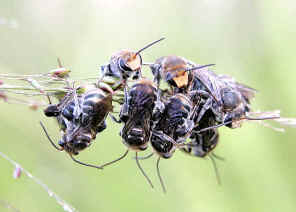Family Halictidae - Halictid Bees, Burrowing Bees
Order Hymenoptera

- Bees in family Halictidae are usually black with metallic colours green or blue. They are from small to medium in size. Halictid Bees have short pointed tongues and feed on different shallow flowers. They have pollen-carrying scopa on hind legs and bottom of abdomen. Forewings have three sub-marginal cells.
- They are solitary (each female bee build nest, lays and cares her own eggs) or communal (share nest with other female but care her own eggs) but not social. Females nest in ground, or less often, in rotting wood. Males do not nest but cluster together at night.
This page contains pictures and information about Burrowing Bees in Family Halictidae that we found in the Brisbane area, Queensland, Australia.
Subfamily Halictinae
- 1st and 3rd sub-marginal cells markedly unequal in length, 3rd much shorter.
- Small Metallic-green Bee


- Homalictus sp., body length 6mm
- Bees in genus Homalictus are often metallic green or blue in colours with dark brown abdomen. Some species have the abdomen red. For more information please check this page.
- Small Metallic-banded Bee


- Lasioglossum sp., body length 10mm
- Bees in genus are often black in colour with metallic colour bands on abdomen. They have hairy hind legs and abdomen for carrying pollen. Please check this page for more information.
Subfamily Nomiinae
- 1st and 3rd sub-marginal cells equal in length, with much shorter 2nd sub-marginal cell.
- Green and Gold Nomia Bee


- Lipotriches australica (Nomia australica), body length 10mm
- The bees have golden yellow bands on their abdomen. On their head there are the large brown compound eyes, long antenna and golden yellow face. Males cluster together on glass stem for the night. Please check this page for more information.
- Black Nomia Bee


- Nomia sp., body length 12mm
- We recognized this Black Nomia Bee by the forewings vine pattern. The 1st and 3rd sub-marginal cells equal in length, with much shorter 2nd sub-marginal cell. There are the vertical white strips on thorax. Please check this page for more information.
- Gold-barred Nomia Bee
-


- Nomia sp., body length 10mm
- We recognized this bee by its forewing vein. Forewings have three sub-marginal cells. The 1st and 3rd sub-marginal cells equal in length, with much shorter 2nd sub-marginal cell.. They have pollen-carrying scopa on hind legs and bottom of abdomen. Please check this page for more information.
- Reference:
- 1. Native Bees of the Sydney region, a field guide - Anne Dollin, Michael Batley, Martyn Robinson & Brian Faulkner, Australian Native Bee Research Centre. P42.
- 2. Northern Territory Insects, A Comprehensive Guide CD - Graham Brown, 2009.
